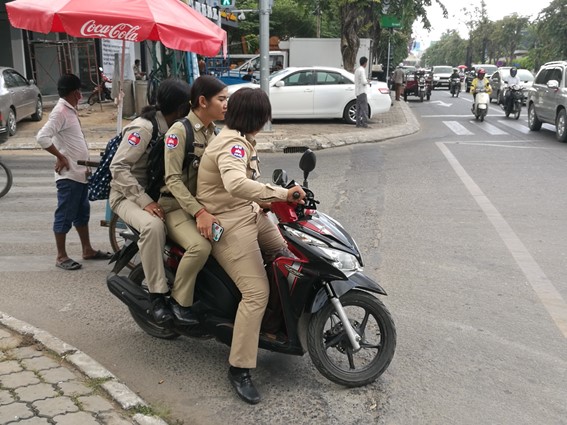ATW90. Cambodia
This is the second in a series of posts I am making, which will be extended to create a book, Around the World in 90 Minutes.
Please send any comments or inaccuracies to atw90@leohoenig.com
For future posts, where I am going, follow me on facebook.com, twitter @leohoenig and Instagram @hoenigleo
Bangkok may be frenetic, but it is an oasis of calm compared to the first visions that a visitor to Phnom Penh receives. I have had the sense to be met at the airport, by a reasonably priced hotel car. It gives me a final hour of air-conditioned comfort as it waits, stuck in traffic.
My hotel room is small, but not bad, I would have appreciated it if the air conditioner there was a little more effective. It is about a 30-minute walk to the stadium, so once I have freshened up, I decide to make my way there. I quickly lose count of the number of tuk-tuks and moto taxis that ask for my custom, but it must have exceeded 100. All the way along the road, even the major roads, the pavements were blocked by shops spreading their wares out, or by parking the mopeds that are the preferred form of transport for all that can afford them. Hence any pedestrian is forced out onto the road.
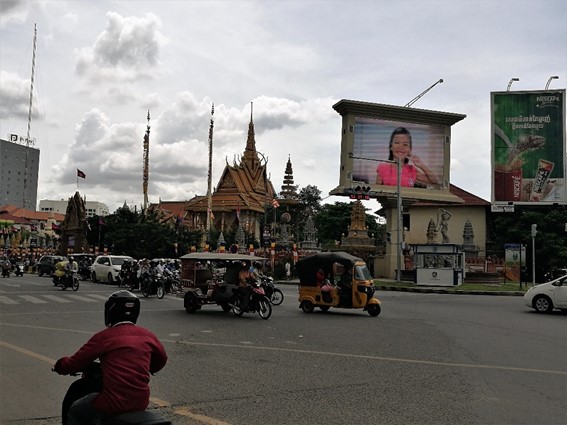
Close to the stadium, there is a rush of tuk-tuks, mopeds and cars as the lights change
It takes a while to realise why no one cares, there are almost no pedestrians at all here. There is hardly anyone who cannot travel using the transport available. Moto taxis, by the way actually mean riding pillion on the back of a moped, without a helmet, and with a good chance of a (low speed) collision at every junction, so tuk-tuks are my preference.
Over the few days in Phnom Penh, I find some of the rules of the road, such as at traffic junctions with crossing signals, the green man means that generally vehicles will only come at you from one direction, and even they will try to miss you. Still, you never get to the point where a tuk-tuk driver believes that a foreigner should be walking. The normally approach you in the few yards between exiting the previous tuk-tuk and entering the building that was your destination. And naturally if they have just seen you walk past and refuse the approach of one driver, they have no reason to suspect that you might say the same to them.
Finding the offices of the Football Federation at the stadium, they tell me to come back later in the afternoon to collect accreditation. I use the time wisely, walking again as far as a craft brewery that has a good location between stadium and hotel. After trying their beers, which both good and varied, the smoky porter being the best of the batch, I continued my walk and got back to the hotel.
I can never be sure of press accreditation, and I notice as I pass the window that all category one tickets have been sold out. Category 2 tickets are on sale for 5000 Riels. Most transactions in Cambodia take place in US dollars, but they use the local currency for small change. While there is a variable rate of exchange, the “on the street” value is always the convenient 4000 Riels = 1 US Dollar. Hence I handed over $2 and was given 3000 Riels change, plus this
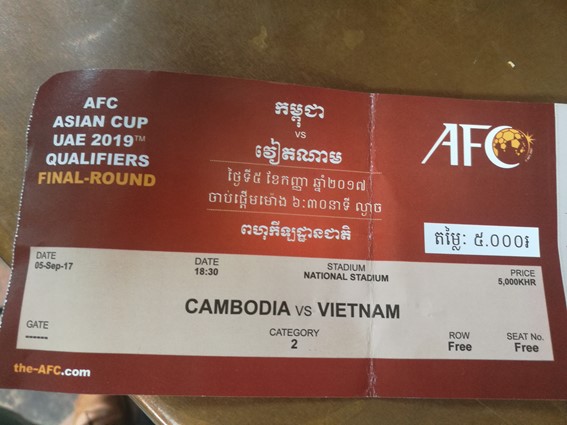
I reckon that’s 97p in English money, and as it turns out, I get the accreditation anyway, and tickets were available on the day.
The match is played at the Olympic Stadium, which despite the name was built for the 1963 South East Asian games. These games were never held due to the political situation at the time.
The stadium is a fine old bowl in true communist style.
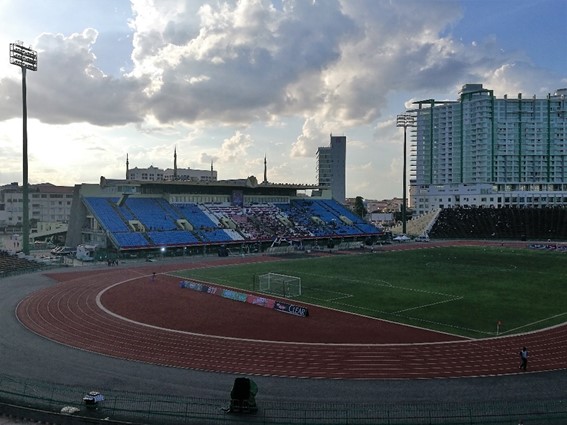
One major side, and a giant sweeping curve of concrete seats around almost the whole of the rest.
Officially, the stadium can hold 55,000 – with no handrail or crush barrier in sight, it would not hold 5,000 in line with safety standards in Europe.

One enters from a low level, and getting in on matchday involves entering through narrow pathways caused by temporary wheeled fencing tied into place. You then have to jump over the joins between the fences. I saw no way for someone who was not relatively capable to get in, and no wheelchair access.
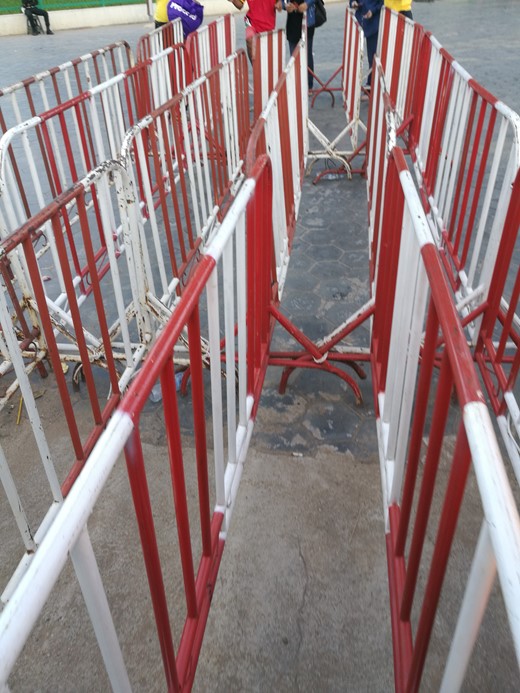
Way in?
From this point, you climb a steep staircase, which leaves you at the top level above all the seats. You can walk around the stadium at this height, and there is a level patio area running back from the seats opposite the main stand, with many food stalls open.
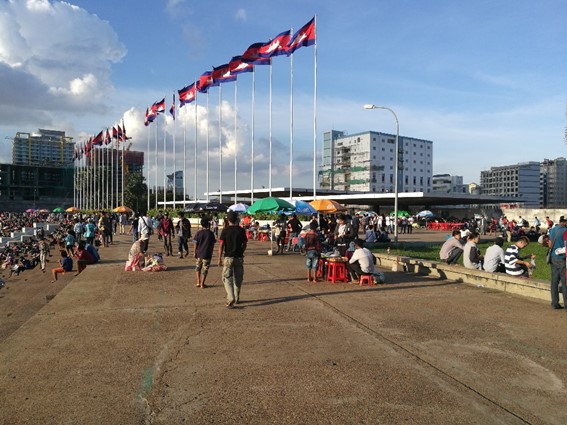
While most of the other large countries within South East Asia have held the games on multiple occasions, Cambodia, having missed out in 1963 still have not staged the event. They have now been given the rights to stage in 2023.
However, this old stadium will not be used then, as the building of a new facility to the north of the city has already started. Parts of the edges of the site, (not the stadium itself) have been developed as condominiums in order to fund a refurbishment about ten years ago. No one knows how much of the stadium will survive once the new facilities are open, but it is popular locally, as a quiet space in the centre of the city.
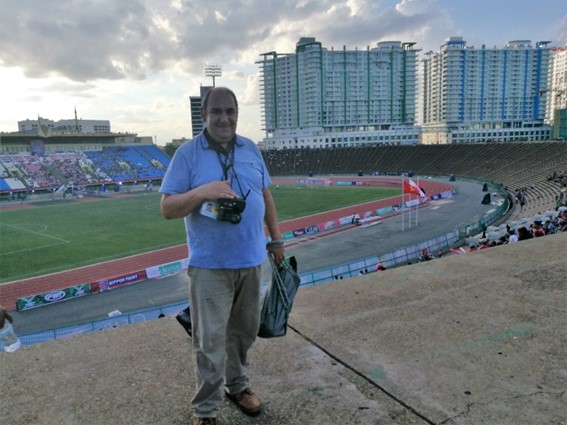
It does not take long for the game to spring to life, in the fourth minute, Vietnam score a goal of stunning simplicity, that makes you wonder if Cambodia are going to suffer a very heavy defeat. It was a chested knock down, and then a straight low shot by Nguyen van Quyet from outside the box. Most of the visiting support if just below me to the right, and they light up red flares and smoke bombs as they celebrate the opening goal.
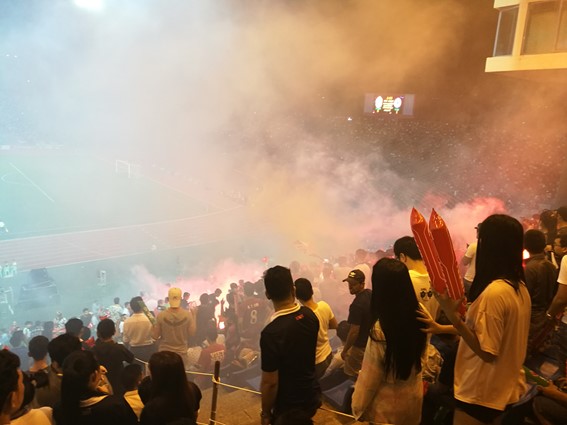
It appears that Vietnam have three centre halves and no full or wing backs. This gives Cambodia an invitation to attack, they push at the three defenders and force a corner. The corner is cleared following a long punch from the keeper, Vietnam race in to attack, four against three, but lose possession and the non-existent defender is easily passed, the ball moved to Chan Vathanaka on the other side, and Cambodia level at 1-1. Now it is the Cambodian supporters that are standing, waving the clappers that have been given away free on the gates as they go.
For Vathanaka, it is a relief to be properly on the pitch. Earlier on the season, he transferred on loan to Fujieda in the Japanese 3rd Division, but since has not started a game.
It transpires that Vietnam are playing 4-4-2, but that not all the players are aware of this. It only takes 17 minutes for Vietnam to decide to change the right back for someone who might actually play right back. The player going off develops a limp as he exits the field but had showed no earlier sign of distress.

The early play, when both on and off the field, the action was as frenetic as the local traffic settles down a bit, and Vietnam look the more comfortable on the worryingly unevenly coloured synthetic surface. On 19 minutes, a free kick from square position by Vietnam’s Vu Minh Tuan bounces off the bar. Cambodia can still cause problems, even if the decision to actually have someone at right-back has settled the visiting defence. Just before half time, Vathanaka gets a clear header which he places over the bar, and as a result we reach the half way mark at 1-1.
The stadium is much fuller than I would have expected. I was aware that all the category 1 seats in the main stand had been sold, but I am surprised by the numbers sitting opposite, the crowd is thinner behind the goals, but clearly, there is support for the live game here. I can see a phalanx of insect life attracted by the lighting at the top of the stand, and also a few small bats taking delight in the free meal so provided.
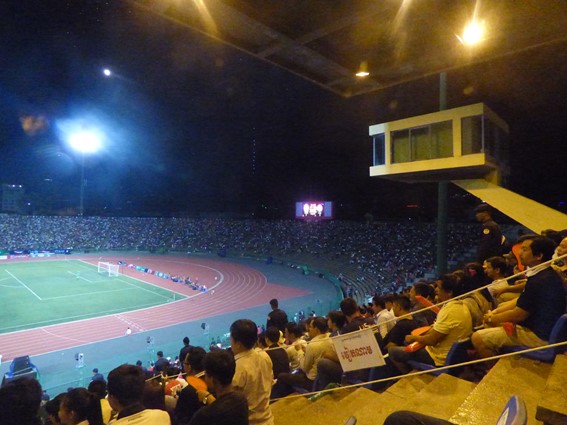
The second half was much quieter, interrupted as they all are by substitutions and injuries. Still, Vietnam were gradually taking control, Cambodia were finding it difficult to get across the half way line without losing possession, while Vietnam could get close to the penalty area. An annoying penchant to fire the ball into the area from distance meant most attacks were cleared with ease.
Maybe this was a deliberate ploy, Cambodia were getting used to long balls being fired in, and being able to clear them with ease, but with about ten minutes to play, the ball was crossed from closer to the bye line, and Vietnam’s substitute attacker Nguyen Quang Hai was left unmarked to put them ahead.
Cambodia did get back on the attack now, but a dive in the box, ignored by the ref, and a clear offside were their closest options. Still there was enough hope that the board for six minutes injury time was greeted with a cheer. It turned out to be a vain hope as Vietnam had the only clear chance in the period.
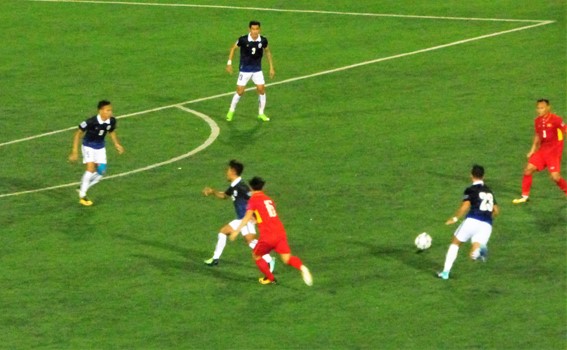
A Vietnam attack late in the game
I turn up at the press conference, mainly because I wanted to try and corner the home officials. While I do this, they do not deliver on their promises to e-mail me in the morning. It was interesting to hear the home coach, Leonardo Vitorino bemoan that he just does not have good enough players to deliver results.
Vitorino is one of the legion of coaches that seems to traipse across the world, taking two year contracts with clubs or countries, and normally getting sacked after one or less. Looking at his list of clubs on Wikipedia, it seems shorter than some, with more coaching jobs rather than the top managerial position. He seems to be resigned to the fact he will get his marching orders either as a result of Cambodia’s non-qualification for the 2019 Asian Cup, or due to poor results in the 2018 AFF (ASEAN Football Federation) Cup.

The central market provides a cool oasis of calm in Phnom Penh
Before I go to the FFC offices again on the Wednesday, I take the walk up to the Army stadium, which appears to be one of the major venues in the Cambodian League at the moment, four or five teams regularly playing there. It is a walk that takes me through the central market and past one of the best temples (Wats) in the city. These provide a respite from the blaring horns and tuk tuks. I also stop at a small local café for an iced coffee and to see some of the previous night’s Uzbekistan v South Korea World Cup qualifier. It appears that any time of day or night in Cambodia, you can pass a café with a TV showing some type of game. The cable channels replay the last series of live games over and over again until there is something new to show
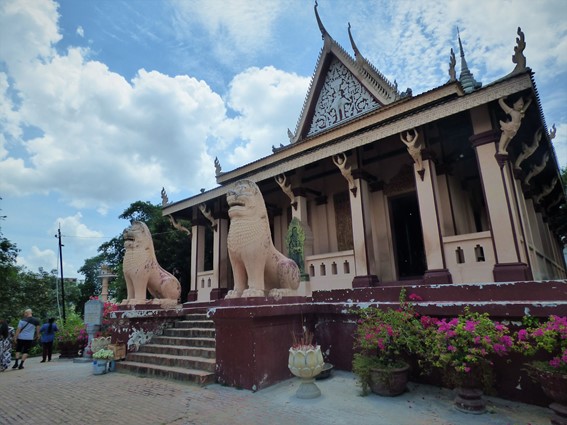

The lack of grass across the centre of the pitch testifies to its over use. There are four people in the office, when the only apparent task is selling replica Army FC kit. I am there for about 20 minutes, and they sell four, which I thought was a good throughput. The largest size was L, so I did not buy my own.
They had a list of fixtures to be played for the rest of the season at the stadium, but no reference to the full list of matches and venues in the league.
When I return to the National Stadium, and the FFC offices, this list is now available. As far as official comments were concerned, it was clear the staff in the offices would not say anything but refer to their chiefs, who were somewhere outside the country.
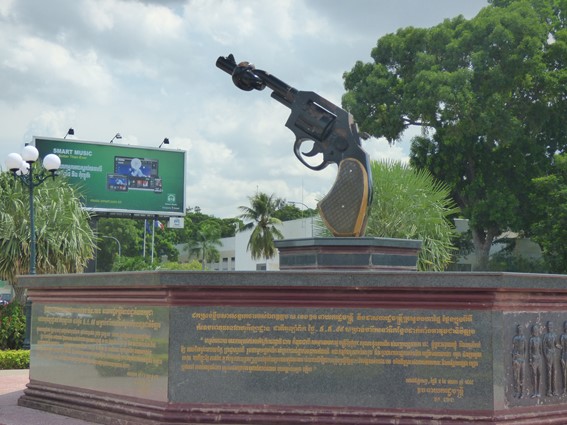
On a roundabout close to the Army stadium is the “Tied Gun” monument. A slightly odd demand for peace? As a response it appears that while the government still considers it OK to lock up the opposition, they are not subject of arbitrary death sentences.
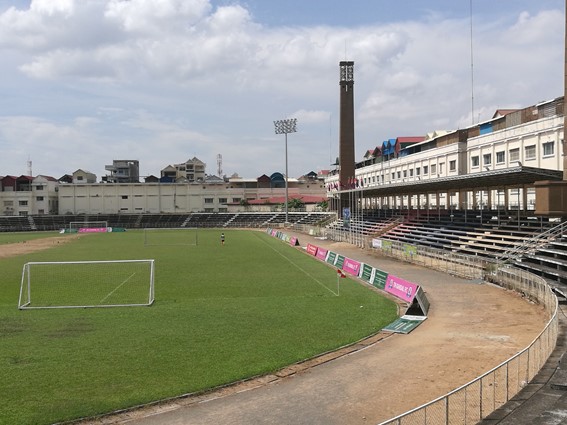
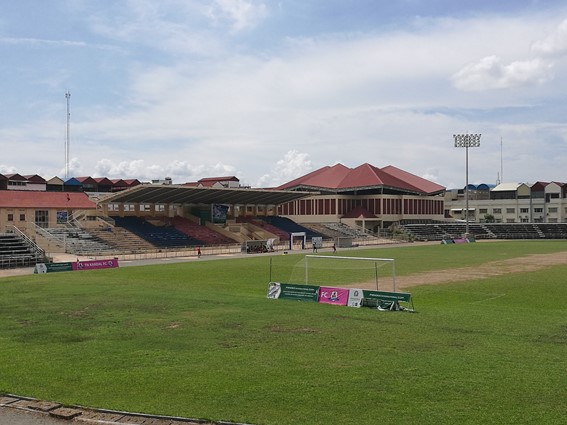
However, once you start talking football to people, they soon want to tell you what is going on. So, I managed to ascertain that the Cambodian Football League is semi-professional at the moment – the players may be paid for football, but many have other jobs as well.
The FFC is trying to persuade some clubs to nominate venues away from Phnom Penh for their matches. This has actually been quite successful, even if only about three venues are currently in use. These are in Svay Rieng and Kirivong for teams which include the location in their name, and Siam Reap for Cambodia Tiger. In Phnom Penh itself, there are four stadiums in use, National, Army, Western and RSN.
The matches played outside the capital are reported to attract relatively large crowds, in the thousands, as opposed to hundreds.
However, apparently all the teams are still Phnom Penh based and train in the capital. They then bus out to the designated city for matches. This is where the FFC sees its next priority, it wants the clubs to not just adopt a “home stadium” as they have now done, but to set up bases outside the city. They can take on youth development work in the areas. Currently, there is no localised coaching schemes outside the capital, and players only have whatever coaching is taught in the schools.
My final thought from the capital, while wandering back to the hotel, is three policewomen sharing a motorbike. I assume they were on the look-out for motorcyclists breaking the law by riding without a crash helmet. After I took the picture, they did a u-turn and headed the wrong way down a one-way street
